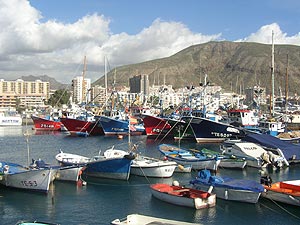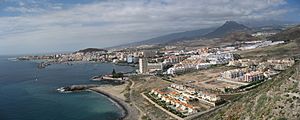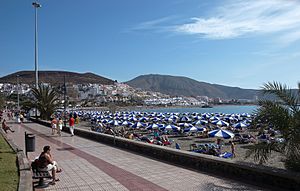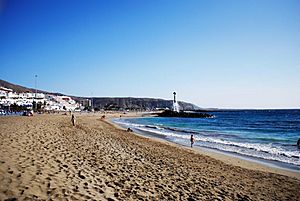Los Cristianos facts for kids
Quick facts for kids
Los Cristianos
|
|
|---|---|
|
Town
|
|

Los Cristianos harbor
|
|
| Country | Spain |
| Autonomous community | Canary Islands |
| Province | Santa Cruz de Tenerife |
| Island | Tenerife |
| Municipality | Arona |
| Time zone | UTC0 (WET) |
| • Summer (DST) | UTC+1 (WEST) |
Los Cristianos is a lively town in Spain. It's on the sunny south coast of Tenerife, which is one of the Canary Islands. In 2017, about 21,235 people lived there. The town is part of the Arona area. It sits between the Chayofita mountain and the larger Guaza mountain.
The town center is around the Los Cristianos bay. However, it is quickly growing inland with many new buildings. Los Cristianos is a very popular place for tourists. It has a busy ferry port and two lovely beaches.
Unlike its busy neighbor, Playa de las Américas, Los Cristianos has a long history. It was a quiet fishing village before tourism became popular in the 1970s. You can still see old buildings that show its humble beginnings. Now, the town has many hotels, resorts, bars, and restaurants. The ferry port is a starting point for fun trips. These include watching dolphins and whales, and going game fishing.
Contents
History of Los Cristianos
Early Days and Port Development
People first mentioned Los Cristianos in the 1500s. Back then, it was known as a harbor. For many years, it was an important port for southern Tenerife. But it wasn't settled until the late 1800s. This was because of attacks from pirates. There weren't enough people to build a strong castle or fort.
The first permanent homes in Los Cristianos appeared in the 1860s. At that time, it was described as a small village. It had three one-story houses, one two-story house, and a small hut. By 1888, official papers recognized it with 29 houses and a cave.
The town's population grew around the early 1900s. This was thanks to new industries and trade. With pirates no longer a threat, Los Cristianos became a busy center for imports and exports. In 1909, the first dock was built. It was used to ship products from a local factory. This old dock is still there today and is called "El Puerto Viejo" (The Old Port). Other businesses included a factory that made resin, nearby salt mines, and a fish salting factory.
Growth and New Buildings
Agriculture started in Los Cristianos when the land was watered. In 1914, Teofílo Bello Rodríguez got permission to bring water from his land to Los Cristianos. This helped the economy grow even more. Farmers started planting tomatoes and bananas. This created new jobs for workers.
By 1924, the growing population needed a place of worship. So, the people built the Chapel of Our Lady of Mount Carmel. This chapel was taken down in 1987. A new, larger church was built in its place in the center of town.
In 1934, a bigger port was built in Los Cristianos bay. This port could handle larger ships. It helped fishing grow and made commercial shipping more important. A new and even bigger port was built on the same spot in 1975. This new port started a daily ferry service. It connected Los Cristianos with the nearby island of La Gomera.
Around the time of World War II, some defenses were built. There were at least three small bunkers along the coast. These were possibly to protect against a planned invasion. Spain was officially neutral during the war. Some of these old defenses are still standing today.
Since 2015, Los Cristianos has been the main office for the Islamic Federation of the Canary Islands. This group brings together Muslim communities in the Canary Islands.
Tourism in Los Cristianos
How Tourism Began
A Swedish man named Bengt Rylander came to Los Cristianos in 1956. He had multiple sclerosis. He hoped the warm weather and clean air would help him feel better. He recovered well and told his friends in Sweden about the sunny climate. Since he was a writer and TV commentator, the news spread quickly. In 1957, several friends joined him. They suffered from poliomyelitis and rheumatic diseases.
So, tourism in Los Cristianos started in the late 1950s and early 1960s. It was a place for sick and recovering Swedes. These early visitors left their mark on the town. The main street in Los Cristianos is called "Avenida de Suecia" (Avenue of Sweden). The "Casa Sueca," which is now a Swedish Lutheran Church, is located by the sea.
Growing Popularity
Tourism wasn't just for Swedes. More and more visitors came from other European countries. In the 1960s, the first large buildings were constructed in Los Cristianos. These were built to house the growing number of tourists. They included Cristianmar, Rosamar, and the Oasis Moreque Hotel. The steady number of disabled Swedish visitors also led to the opening of the Vintersol rehabilitation clinic in 1965.
You can see some old photos of Los Cristianos from its early days. They are displayed in the Hotel Princesa Dacil near the beach. Many old pictures from the late 1960s and early 1970s show the town's construction.
While tourist numbers grew steadily in the 1960s and 1970s, tourism really boomed after 1978. That's when the new International Airport (Reina Sofía) opened in southern Tenerife.
Many large hotels and apartment buildings were built in the 1970s. They housed the increasing number of tourists and workers. But the town grew massively in the 1980s. Besides holidaymakers, Los Cristianos also attracted many British expatriates. They moved there permanently or for part of the year to escape cold British winters. English is spoken as widely as Spanish here. There are also many British-owned bars, restaurants, shops, and services. These mainly serve the tourist community.
Beaches in Los Cristianos
Los Cristianos has two popular beaches. The main beach, called Playa de Los Cristianos, is sandy. It is protected by the harbor. It offers many things to do, like watersports, beach volleyball, showers, and a children's play area.
Las Vistas Beach is in the next bay past the harbor. It is man-made and protected by barriers. It also has many facilities, including watersports, showers, and a tourist information center. In December 2008, the Los Cristianos promenade was updated. It was first built in the 1970s.
There is also a rocky beach with black sand in the "Rincón" area. This area is between the headland near the Old Port and the cliffs of Montaña Guaza.
Economy of Los Cristianos
Tourism and Local Business
Today, Los Cristianos is a busy tourist spot. It attracts hundreds of thousands of visitors every year. There are many hotels and self-catering holiday apartments. You can book them directly or through major travel companies. Businesses related to tourism are the main employers in Los Cristianos.
Los Cristianos also has many bars and restaurants. They offer different styles of food, from 'tapas' bars to high-quality local and international dishes. Eating out is not expensive. So, many visitors choose accommodation where they can cook for themselves or have half-board meals.
Because tourism grew so much, farming declined. The last banana crop was harvested in the early 1990s. A small fishing fleet still operates from the harbor. But commercial shipping has mostly been replaced by fun cruises and ferry services. These ferries go to the nearby islands of La Gomera, El Hierro, and La Palma.
Los Cristianos is also a major business center for southern Tenerife. It has a lively main street with many small stores. These shops serve both tourists and local residents. There are also several small shopping malls and major supermarket chains.
Los Cristianos is quickly becoming the main administrative center for southern Tenerife. It has its own "Centro Cultural" (Cultural Center). This center handles many tasks usually done by a town hall. Los Cristianos is also home to the "Juzgados de Arona" (County Courts).
Transport in Los Cristianos
Los Cristianos is connected to the island's capital, Santa Cruz de Tenerife, by the TF1 Motorway. It is also connected to the Tenerife South Airport by this motorway. The town has its own bus terminal. Regular bus services go to other parts of the island.
Daily ferry services also leave from Los Cristianos harbor. These ferries go to the nearby islands of La Gomera, El Hierro, and La Palma. The ferry companies that operate here are Naviera Armas and Fred Olsen Express. The Fred. Olsen Express company took over a route that was previously run by another ferry company.
The town itself is best explored on foot. It has many wheelchair-friendly walking paths and a long promenade along the beach. Taxis are easy to find within the town. The port of Los Cristianos is the busiest in Spain for passenger traffic. This is because of its links to the ports of San Sebastian de La Gomera, La Estaca in El Hierro, and Santa Cruz de La Palma.
Photo gallery
See also
 In Spanish: Los Cristianos para niños
In Spanish: Los Cristianos para niños









